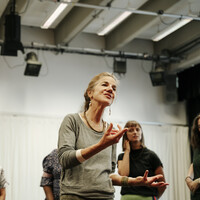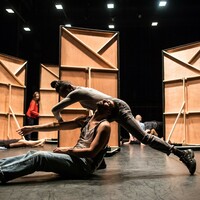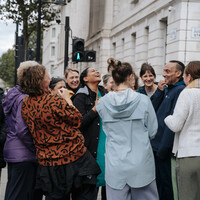Choreographer Yuval Pick on working with BA students at London Contemporary Dance School

News Story

Yuval Pick is a choreographer and the director of the National Choreographic Center (Centre Chorégraphique National) of Rillieux-la-Pape (France). Yuval Pick has a long career as a choreographer, a dancer and a teacher. He first trained at the Bat-Dor Dance school in Tel Aviv, then joined the Batsheva Dance Company in 1991. Four years later he left to begin working as an international guest artist with, among others, Tero Saarinen, Carolyn Carlson and Russel Maliphant. In 1999 he joined the Opera Ballet of Lyon, and founded his own company, The Guests, in 2002. Since then he has created a strong repertory of works marked by their elaborated, layered movement vocabulary, accompanied by commissioned scores by ranking composers. In his work the relationships between individuals and group(s) are often highlighted and challenged.
How have you found working with our students?
I’ve found it very interesting. I really enjoy the fact that they are very different from each other. The piece I created deals with how to accept the difference, and how to create a group with the difference of each other. So, I really enjoy that, there is something interesting about the different personalities
It’s very important for me that in this piece you don’t have to be as one, you have to do as one. Everyone brings their personality and singularity, but we don’t have to be like the other ones in order to be together. That’s very different – not to be one, but to do one. Everybody is responsible, there is a personal responsibility to contribute at the same time as listening to what the others are doing.
What does it feel like to bring a seminal piece back to live interpreted by a new generation of dancers?
The piece was first created in 2018, with Palestinians living in Israeli territories, with Jewish Israelis, and with French people that come through immigration – the group was so mixed. The idea for me was that dance was a way to go over borders, go over frontiers, and to communicate in a different way. First of all, dance is a language, so if you learn how to dance as a language, you can cross borders. You can reach someone that maybe, in the verbal world, is an enemy, but in the non-verbal world could be an ally. That’s what dance brings—a holistic human sense. We can relate to each other, share what we are, we negotiate fear, anger, and hate—we have to do it every day, otherwise we wouldn’t be alive. Dance is a practice that renders possible the sense of peace, the sense of communication with someone who is different from me, who may have different opinions to me, but still we can communicate because we’re human beings, and we can respect each other.
So that's the piece. I took this idea and gave it to different people: it was done for intergenerational people, it was done with very good dancers in Paris Conservatoire, it was done for The Place, then I went to New York to bring it to their programme. The idea is that it’s your responsibility to contribute to a common space—be who you are but also accommodate the others.
With this group of students, I feel like there’s an intersection between a lot of nationalities. They dance my movement—they don’t have to do it right, they have to have the right intention. We don’t work on the form, we work on the intention. The right rhythm, and the right intention, and then they do it how they bring it.
The dance industry has changed a lot since 1999. Do you see the work with different eyes now or how has it changed?
I think in my generation the relationship to hierarchy and authority was very different. Now, the young generation has much more access to all the information. What they don’t have is experience. And this is very delicate. One thing that can never be replaced is a human experience—no robots, no AI, nothing. And that’s wonderful. Because that’s what dance is about—dance is about how to render visible life experience through movement.
I try to give the students information in order to nourish their experiences. Because the information from all the media and the internet—it's not a human experience. You need to get dirty. And humbleness. How do you teach humbleness when they think they already know everything? Always be a student, always learn, always acknowledge that there are things you need to enrich yourself with, in order to learn and reveal layers in your personality, in order to open up more to others. It’s a constant work, and it requires humility in order to listen to this kind of process.
Keeping repertoire alive is not something we are necessarily very good at in contemporary dance. Why is it important to revisit work as well as look forward?
Because our art is ephemeral. We are not a museum. We are alive, we are onstage, it is a performance and the public are witness to it. We need this ritual of performing and the public watching it. It’s where the piece goes out. You can rehearse in the studio ten thousand times, but that’s not how it goes when people are watching it—it's a completely different event. There are some works that get older, but there are some pieces that are evergreen. Pieces that can always be alive, and this is not something that you can control. For me it’s important to revisit certain pieces that are still very tangible and very important for the world of dance and the world of today.
What is nice when you revisit pieces is that you allow them to develop. It’s very delicate but I'm very happy to have a repertoire that is still alive.
Bradley, Flowers, Smithereens is a very exciting triple bill of three high caliber choreographers. How do you feel about the opportunity for audience to see contemporary dance work curated in this way?
For the public it’s wonderful, because they’ll see dance in three different ways. You’ll see three ways to communicate the art of dance. I think it’s very rich, and it takes people out from the banality of Netflix, Amazon Prime, and all the things that look the same, even with the same costumes. It escapes the banal way of presenting human beings – it's rich and multiple and full of flavour.
Is there anything you’d want to say to dancers who are deciding whether they want to pursue a career in the performing arts industry?
Students today should be very aware of the situation and be even more connected to their joy and their motivation for dancing. If they don’t find this motivation, don’t dance. Or dance, but don’t practice dance as a profession. You always need to find why you are dancing and have a clear motivation. If it’s not clear, it will be very difficult. Find the joy of dancing, but also the joy of becoming an artist. Everybody can dance, which is great because dance is something very archaic, but to be an artist of dance is to have the capacity to render tangible and visible our human soul through movement. It’s materialising. It’s an art form. But it’s hard work. It’s really hard work, and you have to be very perseverant. You have to always find the joy to want it, to exercise the need, and to have the motivation.


